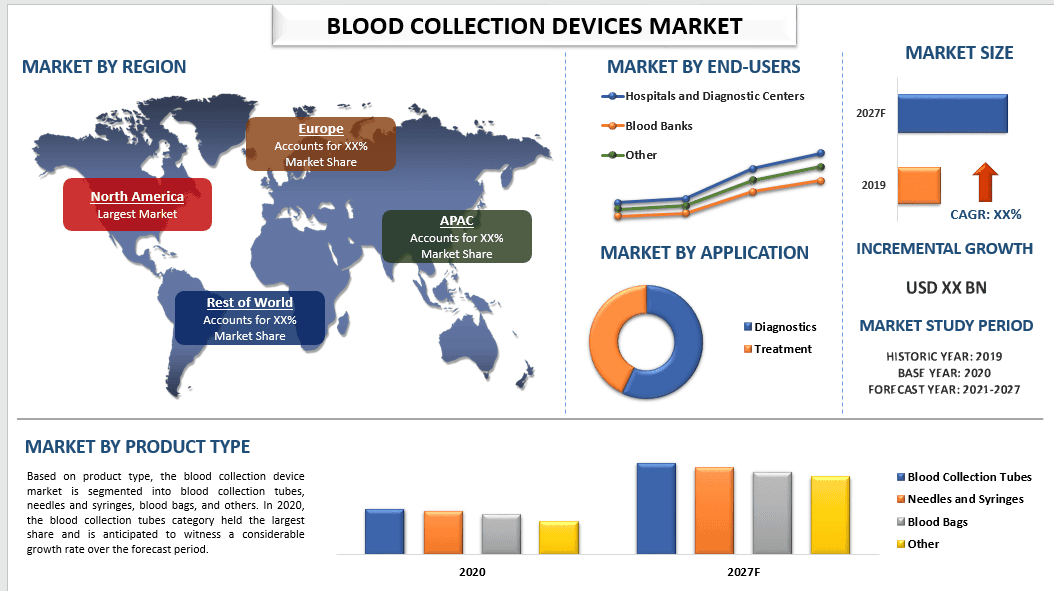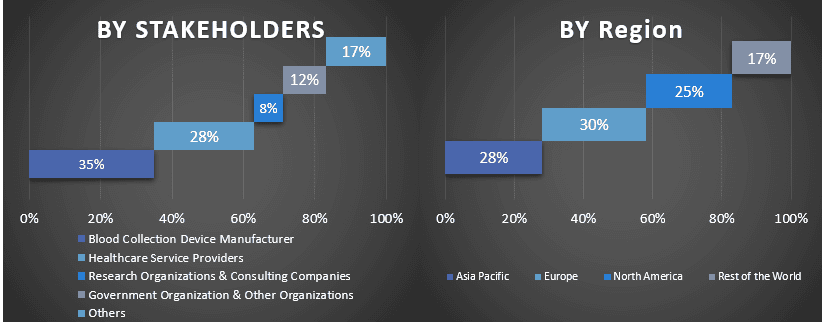- Home
- About Us
- Industry
- Services
- Reading
- Contact Us
Blood Collection Devices Market: Current Analysis and Forecast (2021-2027)
Emphasis on Product (Blood Collection Tubes, Needles and Syringes, Blood Bags, Other); Application (Diagnostics, Treatment); End-User (Hospitals and Diagnostic Centers, Blood Banks, Other); and Region/Country

The blood collection devices are expected to witness a CAGR of around 7% during the forecast period (2021–2027). The growth of the blood collection devices market can be attributed to the growing geriatric population coupled with the surge in the prevalence of blood cancers. This growing number of people suffering from blood cancer is leading to an increase in demand for its treatment and blood transfusion as almost every patient with leukemia may require some transfusions during their care. Thereby, boosting the growth of the blood collection device market. For instance, according to the Leukemia and Lymphoma Society (LLS), approximately, 186,400 people in the U.S. were diagnosed with leukemia and lymphoma in 2021. In addition, 825,651 people were diagnosed with lymphoma in the U.S., 152,671 people diagnosed with Hodgkin lymphoma, and 672,980 people diagnosed with non-Hodgkin lymphoma. Furthermore, the increasing number of surgeries performed worldwide due to the high rate of injuries and road accidents across the globe is also one of the prominent reasons contributing to the growth of the blood collection device market.
Becton, Dickinson and Company, Cardinal Health, Terumo Corporation, FRESENIUS KABI, Henry Schein Inc., McKesson Corporation, Medline Industries Inc., Smiths Medical, Quest Diagnostics, Nipro Medical Corporation are some of the key players in the market. Several M&As along with partnerships have been undertaken by these players to facilitate customers with new and advanced blood collection devices.
Insights Presented in the Report
“Amongst Product Type, blood collection category accounted for the majority share in the market in 2020”
Based on product type, the blood collection device market is bifurcated into blood collection tubes, needles, and syringes, blood bags, others. In 2020, the blood collection tubes category is anticipated to witness a significant growth rate over the forecast period owing to the rising prevalence of surgeries (orthopedic surgeries, post-cardiopulmonary bypass, neurosurgery, posterior eye surgery), chronic diseases, blood cancer, hemophilia, kidney disease, cardiovascular diseases, sickle cell disease. For instance, the global burden of chronic diseases is rapidly increasing. Cardiovascular disease is responsible for about half of all chronic disease fatalities. According to the American Heart Association (AHA), the prevalence of CVDs in the U.S. is expected to rise from 38.7% to 40.5% by 2030.
“Amongst Application, diagnostics category is expected to witness highest CAGR during the forecast period”
Based on application, the market has been categorized into diagnostics and treatment. In 2020, the diagnostics segment dominated the market owing to the increasing prevalence of surgeries, blood cancer, diabetes, and cardiovascular diseases, among others. Thus, with an increase in infectious diseases, the demand for diagnostics is also anticipated to drive the market growth of this category during the forecast period.
“Amongst End-User, blood bank category is expected to witness highest CAGR during the forecast period”
Based on end-users, the blood collection devices market is segmented into hospitals and diagnostic centers, blood banks, and others. In 2020, the blood bank category dominated the blood collection devices market and is expected to grow significantly in the forecast period. However, the growth of this segment is owing to the rising geriatric population, road accidents, and raising awareness of blood donation coupled with the introduction of advanced techniques of blood transfusion and collection. Furthermore, according to the World Health Organization (WHO), the incidence of tropical diseases, like malaria, chikungunya, dengue, and yellow fever has significantly increased, driving demand for the market. As detection of these diseases requires various diagnostic devices, the demand for blood collection products is expected to rise in the future.
“North America to witness significant growth during the forecast period”
For a better understanding of the market, the report provides a detailed analysis of major regions and countries including North America (U.S., Canada, Rest of North America); Europe (Germany, U.K., France, Spain, Italy, Rest of Europe); Asia-Pacific (China, India, Japan, Rest of Asia-Pacific) and Rest of World. In 2020, North America accounted for a significant market share owing to the high per capita income and standard of living coupled with better reimbursement policies and well-established healthcare infrastructure, which have energized the regional market. Moreover, the adoption of innovative & advanced technology and a large focus on clinical research drive regional growth during the forecast period. Furthermore, according to Community Blood Center (CBC) data, every day around 43,000 pints of donated blood is used in both the U.S. and Canada.
Reasons to buy this report:
- The study includes market sizing and forecasting analysis validated by authenticated key industry experts.
- The report presents a quick review of overall industry performance at one glance.
- The report covers an in-depth analysis of prominent industry peers with a primary focus on key business financials, product portfolio, expansion strategies, and recent developments.
- Detailed examination of drivers, restraints, key trends, and opportunities prevailing in the industry.
- The study comprehensively covers the market across different segments.
- Deep dive regional level analysis of the industry.
Customization Options:
The blood collection devices market can further be customized as per the requirement or any other market segment. Besides this, UMI understands that you may have your own business needs, hence feel free to connect with us to get a report that completely suits your requirements.
Table of Content
Analyzing the historical market, estimating the current market, and forecasting the future market of the blood collection devices market were the three major steps undertaken to create and analyze the adoption of blood collection devices in major regions globally. Exhaustive secondary research was conducted to collect the historical market numbers and estimate the current market size. Secondly, to validate these insights, numerous findings and assumptions were taken into consideration. Moreover, exhaustive primary interviews were also conducted, with industry experts across the value chain of the blood collection devices market. Post assumption and validation of market numbers through primary interviews, we employed a top-down/bottom-up approach to forecasting the complete market size. Thereafter, market breakdown and data triangulation methods were adopted to estimate and analyze the market size of segments and sub-segments of the industry pertains to. Detailed methodology is explained below:
Seek More Details About Research Methodology
Analysis of Historical Market Size
Step 1: In-Depth Study of Secondary Sources:
Detail secondary study was conducted to obtain the historical market size of the blood collection devices market through company internal sources such as annual reports & financial statements, performance presentations, press releases, etc., and external sources including journals, news & articles, government publications, competitor publications, sector reports, third-party database, and other credible publications.
Step 2: Market Segmentation:
After obtaining the historical market size of the blood collection devices market, we conducted a detailed secondary analysis to gather historical market insights and share for different segments & sub-segments for major regions. Major segments are included in the report as product, application, and end-user. Further country-level analyses were conducted to evaluate the overall adoption of testing models in that region.
Step 3: Factor Analysis:
After acquiring the historical market size of different segments and sub-segments, we conducted a detailed factor analysis to estimate the current market size of the blood collection devices market. Further, we conducted factor analysis using dependent and independent variables such as various products, applications, and end-user of blood collection devices. A thorough analysis was conducted for demand and supply-side scenarios considering top partnerships, mergers and acquisitions, business expansion, and product launches in the blood collection devices market sector across the globe.
Current Market Size Estimate & Forecast
Current Market Sizing: Based on actionable insights from the above 3 steps, we arrived at the current market size, key players in the blood collection devices market, and market shares of the segments. All the required percentage shares split, and market breakdowns were determined using the above-mentioned secondary approach and were verified through primary interviews.
Estimation & Forecasting: For market estimation and forecast, weights were assigned to different factors including drivers & trends, restraints, and opportunities available for the stakeholders. After analyzing these factors, relevant forecasting techniques i.e., the top-down/bottom-up approach were applied to arrive at the market forecast about 2027 for different segments and sub-segments across the major markets globally. The research methodology adopted to estimate the market size encompasses:
- The industry’s market size, in terms of revenue (USD) and the adoption rate of the blood collection devices market across the major markets domestically
- All percentage shares, splits, and breakdowns of market segments and sub-segments
- Key players in the blood collection devices market in terms of solutions offered. Also, the growth strategies adopted by these players to compete in the fast-growing market
Market Size and Share Validation
Primary Research: In-depth interviews were conducted with the Key Opinion Leaders (KOLs) including Top Level Executives (CXO/VPs, Sales Head, Marketing Head, Operational Head, Regional Head, Country Head, etc.) across major regions. Primary research findings were then summarized, and statistical analysis was performed to prove the stated hypothesis. Inputs from primary research were consolidated with secondary findings, hence turning information into actionable insights.
Split of Primary Participants in Different Regions

Market Engineering
The data triangulation technique was employed to complete the overall market estimation and to arrive at precise statistical numbers for each segment and sub-segment of the blood collection devices market. Data was split into several segments & sub-segments post studying various parameters and trends in the areas of product, application, and end-user in the blood collection devices market.
The main objective of the Blood Collection Devices Market Study
The current & future market trends of the blood collection devices market were pinpointed in the study. Investors can gain strategic insights to base their discretion for investments on the qualitative and quantitative analysis performed in the study. Current and future market trends determined the overall attractiveness of the market at a regional level, providing a platform for the industrial participant to exploit the untapped market to benefit from a first-mover advantage. Other quantitative goals of the studies include:
- Analyze the current and forecast market size of the blood collection devices market in terms of value (USD). Also, analyze the current and forecast market size of different segments and sub-segments
- Segments in the study include areas of product, application, and end-user.
- Define and analysis of the regulatory framework for the blood collection devices market industry.
- Analyze the value chain involved with the presence of various intermediaries, along with analyzing customer and competitor behaviors of the industry.
- Analyze the current and forecast market size of the blood collection devices market for the major region.
- Major countries of regions studied in the report include Asia Pacific, Europe, North America, and the Rest of the world.
- Company profiles of the blood collection devices market and the growth strategies adopted by the market players to sustain in the fast-growing market
- Deep dive regional level analysis of the industry
Related Reports
Customers who bought this item also bought










